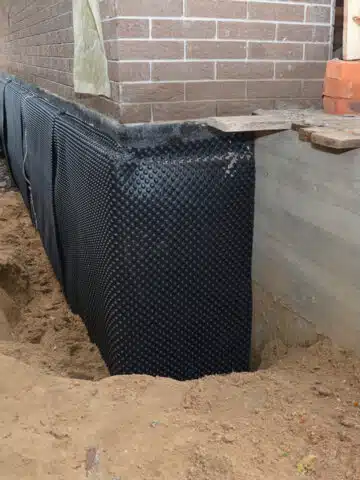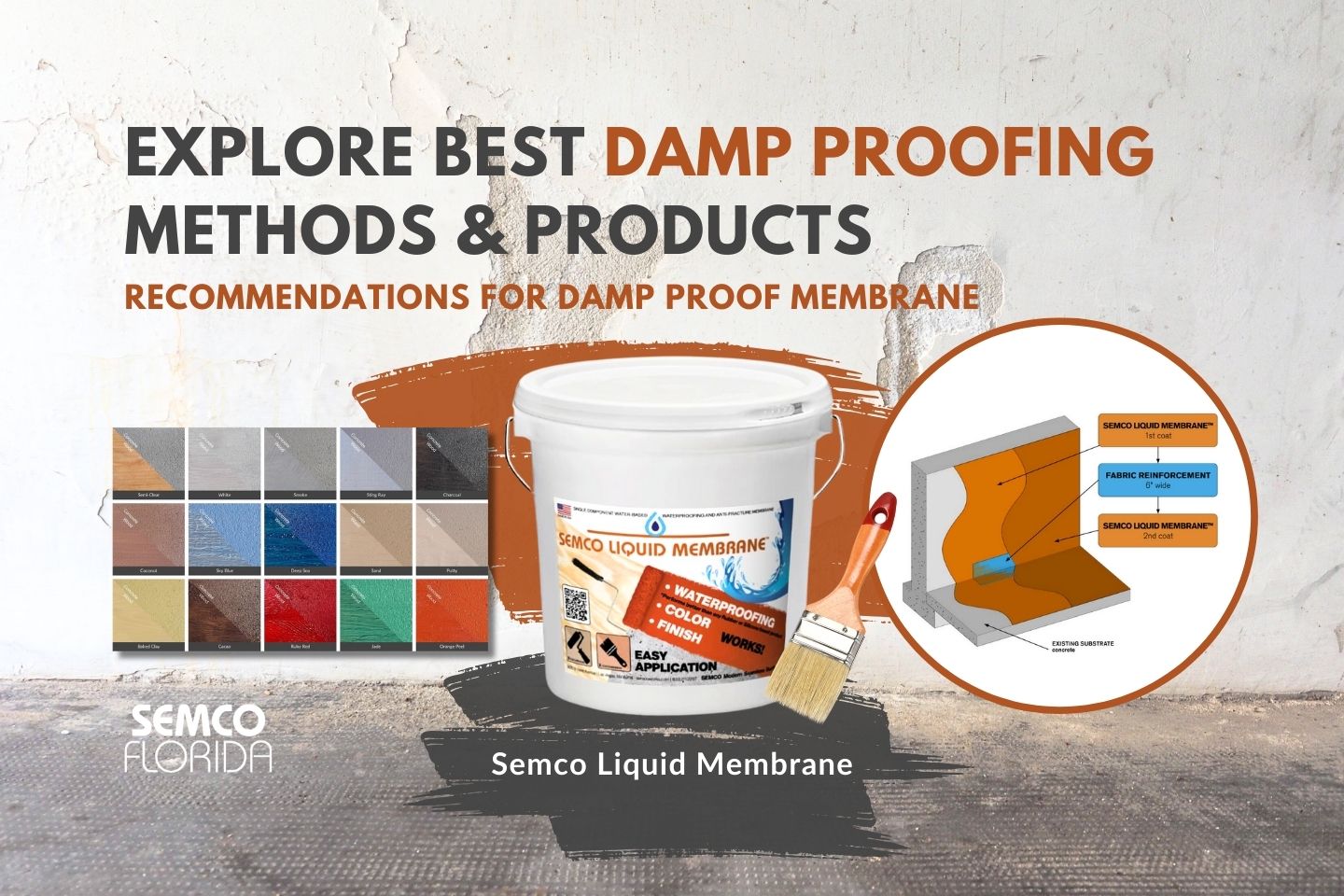Exploring the Numerous Strategies and Solutions for Effective Damp Proofing
Moisture in buildings positions significant difficulties to both architectural integrity and interior air high quality. Numerous strategies and options have actually arised to fight this prevalent concern. From conventional damp-proof membranes to ingenious chemical treatments, each approach supplies one-of-a-kind benefits. Recognizing these options is crucial for reliable wetness control. Nevertheless, choosing the right solution depends on details structure problems and demands, prompting additional expedition into one of the most effective damp proofing approaches available.
Recognizing the Reasons For Wetness
Although wetness can occur from various resources, comprehending these reasons is crucial for effective remediation. Generally, wetness originates from three key resources: rising moist, passing through damp, and condensation. Increasing moist happens when groundwater takes a trip up with porous products, such as brick or stone, commonly as a result of a lack of an efficient obstacle (damp removal newcastle). Passing through damp is commonly triggered by outside aspects, including roof covering leakages, malfunctioning seamless gutters, or harmed walls, enabling water to infiltrate a residential property. Condensation, on the other hand, results from excess dampness airborne, frequently exacerbated by bad air flow and temperature level distinctions, bring about water beads developing on surface areas. Identifying these underlying issues is crucial, as each kind of dampness calls for a tailored technique for remediation. Correct evaluation aids in determining one of the most efficient services, eventually safeguarding the architectural stability of a building and boosting interior air top quality
Standard Damp-Proof Membranes

Chemical Damp-Proofing Solutions
Chemical damp-proofing solutions supply an ingenious technique to avoid moisture intrusion in buildings. These methods commonly include the application of liquid chemicals that penetrate stonework and form an obstacle against rising wet. Generally made use of chemicals consist of silanes, siloxanes, and various other water-repellent representatives that react with surface materials to create a hydrophobic layer.The application procedure normally requires drilling holes right into the wall surfaces, infusing the chemical option, and permitting it to heal. This approach is especially helpful for older frameworks where typical damp-proof membranes may be unwise. Chemical damp-proofing can be less turbulent and more economical than extensive improvement projects.While efficient, these services depend on proper application and ecological conditions for peak efficiency. damp proofing newcastle. Normal maintenance and monitoring are vital to guarantee the long life of the damp-proofing treatment. In general, chemical damp-proofing stands for a flexible option for safeguarding structures against moisture-related damage
Tooth Cavity Wall Building And Construction Techniques
Tooth cavity wall surface construction methods supply countless benefits, specifically in wetness control and energy efficiency. By including an air void between 2 layers of stonework, these walls properly mitigate water ingress while improving insulation. This mix not only secures structures from moisture but likewise adds to lowered energy intake.
Advantages of Dental Caries Wall Surfaces
When considering reliable damp proofing methods, the benefits of cavity walls stick out plainly. Dental caries walls contain two separate layers, creating an air space that properly minimizes wetness penetration. This style lessens the threat of wetness, as the external wall surface works as an obstacle versus rainfall and water ingress. Additionally, cavity wall surfaces boost thermal insulation, which adds to energy effectiveness by lowering warm loss. They additionally supply sound insulation, aiding to produce a quieter indoor atmosphere. Additionally, the air gap enables air flow, which assists in dampness control and lowers the likelihood of mold and mildew development. These benefits not only boost the overall comfort of a structure but also add to its durability and architectural honesty.
Wetness Control Approaches
Efficient wetness control methods are crucial in dental caries wall surface construction to guarantee lasting protection versus moisture. One key method involves the incorporation of weep openings, which help with water drain from the dental caries, preventing build-up. Furthermore, the usage of breathable membranes can help manage moisture levels while allowing caught vapor to run away. Proper placement of insulation is likewise essential, as it ought to not block drainage courses. Guaranteeing that the external leaves of the tooth cavity wall are created with waterproof products boosts overall durability. Normal upkeep checks are necessary to recognize any type of clogs or damage early, guarding the structure's integrity. Inevitably, a mix of these techniques forms a durable defense against wetness intrusion in cavity walls.
Insulation and Energy Effectiveness
Insulation plays an important duty in boosting energy performance within dental caries wall surface construction. By integrating insulating materials, these wall surfaces create a thermal barrier that minimizes heat loss and lowers energy consumption. Reliable insulation not only assists keep a steady indoor temperature level yet likewise alleviates the threat of dampness, as it prevents condensation within the wall surface dental caries. Different techniques, such as the usage of rigid foam boards or mineral woollen, can be utilized to accomplish excellent insulation efficiency. Additionally, appropriate setup is necessary to assure that spaces and gaps are decreased, which can otherwise compromise energy effectiveness. Ultimately, a well-insulated tooth cavity wall adds greatly to general sustainability and decreases cooling and heating costs for house owners.
Outside Damp Proofing Techniques
Outside wet proofing techniques are crucial for securing frameworks from dampness seepage. 2 effective techniques include the application of water resistant membrane layers and the installation of French drains pipes. These solutions assist mitigate water build-up and protect the honesty of buildings.
Waterproof Membrane Layer Application
While various methods exist for stopping moisture access, the application of water resistant membrane layers stays a very effective exterior damp proofing strategy. These membranes are commonly made from products such as polyethylene, rubber, or modified asphalt, giving a robust obstacle against water infiltration. The setup procedure includes using the membrane layer to the exterior surface areas of walls or structures, guaranteeing total protection to prevent leakages. Correct attachment and sealing at joints are essential to optimizing performance. Waterproof membrane layers can be applied in numerous kinds, consisting of fluid finishes and sheet membranes, permitting for versatility based on the particular demands of the framework. This technique not just shields structures from dampness however additionally improves their long life and architectural integrity.
French Drainpipe Installation
One reliable approach for managing groundwater and protecting against dampness accumulation around a building's structure is the installment of a French drainpipe. This water drainage system includes a trench filled with crushed rock and a perforated pipe that redirects surface water away from the foundation. Correct setup calls for careful planning, making sure that the drainpipe inclines far from the framework to assist in ideal water flow. Additionally, the location of the drainpipe is essential; it should be placed in locations prone to merging or excess wetness. Regular maintenance, including clearing up particles from the gravel and ensuring the pipe remains unhampered, is important for lasting performance. Inevitably, a well-installed French drain can greatly decrease the danger of water-related concerns in cellars and foundations.
Inside Waterproofing Approaches
Interior waterproofing approaches are essential for shielding a building's inside from moisture seepage and potential water damages. These strategies usually involve the application of customized products and methods designed to develop a moisture barrier within the structure. One typical technique is the use of water resistant coatings or sealers on walls and floorings, which prevent wetness from passing through surfaces.Additionally, setting up indoor water drainage systems, such as sump pumps, can properly take care of water buildup in cellars and crawl spaces. One more approach entails making use of vapor barriers, which are set up to prevent wetness motion from the ground right into living spaces.Moreover, addressing any cracks or spaces in wall surfaces or structures with ideal sealants assures a detailed protection versus water intrusion. By implementing these indoor waterproofing approaches, residential property proprietors can considerably minimize the threat of mold and mildew growth, structural damages, and other moisture-related issues. Correct implementation of these strategies is necessary for long-lasting defense and building integrity.
Regular Upkeep and Examination Practices
Regular maintenance and assessment techniques are essential for assuring the lasting performance of moist proofing remedies in any kind of structure. Regular checks allow homeowner to identify early signs of moisture invasion, such as peeling off paint, mold growth, and mildewy odors. These indications can signal underlying issues that need immediate attention.Inspections need to be carried out a minimum of each year, focusing on at risk areas like cellars, crawl rooms, and exterior walls. Throughout these assessments, homeowner ought to take a look at sealers, water drainage systems, and ventilation to validate they operate correctly.Additionally, preserving downspouts and gutters is important, as clogged up systems can cause water build-up near the structure. Executing a routine maintenance timetable, together with prompt repairs, can significantly extend the lifespan get more info of damp proofing procedures and safeguard the structural integrity of the structure. Positive measures inevitably contribute to the overall health and safety and security of the living environment.
Regularly Asked Questions
For How Long Does Damp Proofing Normally Last?
The duration of moist proofing efficiency varies, normally lasting in between 20 to 50 years. Aspects such as application top quality, environmental conditions, and upkeep methods considerably influence the longevity of the moist proofing treatment.

Can I Damp Evidence My Home Myself?
The individual contemplated the feasibility of do it yourself damp proofing. With correct study and the best materials, it is feasible. They likewise recognized the value of expert support to ensure resilient performance and prevent future problems.
What Are the Indications of Inefficient Damp Proofing?
Indicators of inadequate wet proofing consist of relentless moldy odors, visible mold and mildew development, peeling paint, moist spots on wall surfaces, and timber degeneration - mould treatment newcastle. House owners need to deal with these concerns quickly to stop further damage and wellness concerns
Does Damp Proofing Affect Indoor Air Top Quality?

Just How Much Does Professional Damp Proofing Price?
Expert moist proofing expenses vary substantially, commonly varying from $1,000 to $5,000 depending on the residential or commercial property's size, the level of the moist problem, and picked techniques. Each scenario needs a tailored analysis for precise pricing. Frequently, dampness stems from three main resources: climbing damp, permeating damp, and condensation. When taking into consideration reliable moist proofing methods, the benefits of cavity walls stand out plainly. External damp proofing methods are crucial for protecting structures from dampness seepage. While various approaches exist for stopping wetness access, the application of water resistant membranes continues to be an extremely reliable outside wet proofing strategy. Indications of inefficient wet proofing include consistent moldy odors, visible mold growth, peeling off paint, damp spots on wall surfaces, and timber decay.
Comments on “The benefits of hiring a mould treatment newcastle professional”